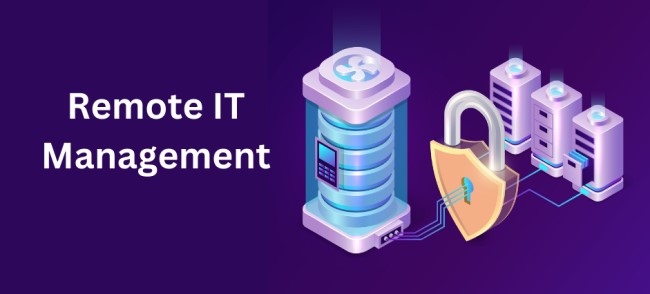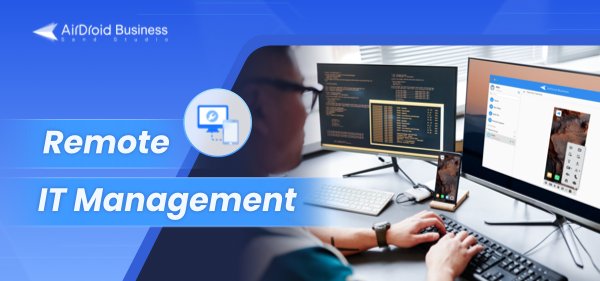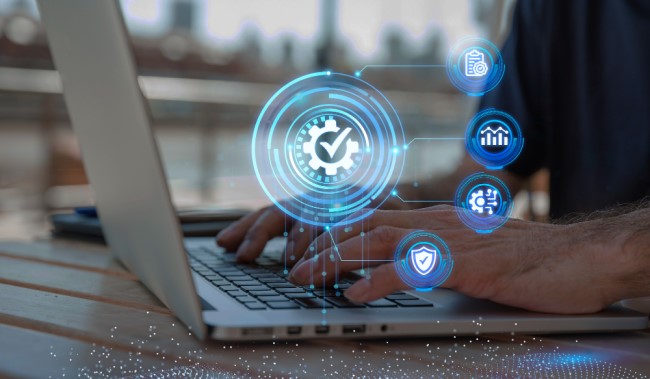What Is Remote IT Management, Features & Best Tools
The management of IT infrastructure is a complex matter. And this difficulty further arises when the components of your IT system aren’t all in one place. The inability to visualize, access and control a dispersed IT system can be frustrating. The solution is Remote IT Management.
Wouldn't it be nice if you could control, update and visualize all your IT assets from a single interface? Well, RMM software helps you do that. It connects your business's various working parts more and increases productivity. Find out how you implement IT remote management software in your company.
- Part 1 : What Is Remote IT Management?
- Part 2 : What Are Remote Managed IT Services?
- Part 3 : 5 Best IT Remote Management Software
- Part 4 : How Does Remote IT Management Work?
- Part 5 : Best Practices: Use IT Remote Management Software for Remote Management And CyberSecurity
- Part 6 : Benefits Of Using Remote IT Management
- Part 7 : FAQS
Part 1 : What Is Remote IT Management?
A company might disperse the working parts of its IT infrastructure across multiple locations instead of a single one. Afterward, It would build a system of monitoring to combine and remotely manage all these parts. This model is called remote IT management.
Such an arrangement allows the remote maintenance of a single IT infrastructure across numerous geographical points. Plus, It lets your IT professionals access and solve problems in any part of the system anytime and from anywhere. The systems they can commonly manage include:
- Servers
- Workstations
- Endpoints
- Networks
- Cloud Services
Remote access and remote monitoring software are two of the vital components of this model. They allow IT professionals to collect and analyze necessary data and remotely control connected devices.
The system also includes patch management software which installs OS updates on the remote devices. Moreover, there is “Backup and Restore” that copies stored data from those devices and stores them.
Every day more industries are appreciating the efficiency of remote IT management. Some of the industries that are benefitting the most. Here're some: IT (cloud services, web development); banking; healthcare; marketing; and education.

Part 2 : What Are Remote Managed IT Services?
Remote Managed IT services manage and maintain a company’s IT infrastructure on an outsourced basis. Such a service can provide the following remote managed IT support.
| Remote Monitoring and Management | RMM means that the provider shall consistently monitor a company’s IT infrastructure. In other words, they will ensure the servers, applications, and networks are secure and working correctly. This helps to reduce downtimes since the experts can identify and solve IT issues before they affect business operations. |
| Data Backup and Recovery | Automated Backup services routinely back up important data and system configurations. They store the data in the cloud. As a result, in an on-premise disaster, you can quickly restore all your valuable company data. Otherwise, cyber-attacks or hardware failures can destroy a century-year-old company within hours. |
| Network Management | Routers, firewalls, wireless access points, and switches constitute a company's network infrastructure. Remote IT management services can uphold, secure and optimize these components. Thus, ensuring fast and unbreached connectivity. |
| Virus Detection | The service provider regularly scans your company’s system with anti-virus software. It would remove malware or ransomware as soon as detected. As a result, the virus is eradicated from your IT systems before it can cause damage. |
| Firewalls | Your business network has to handle a massive volume of incoming and outgoing traffic. And sometimes, undesired or harmful traffic can overload your system and bring your networks down. Firewalls filter out such traffic based on predefined conditions. |
| Software Updates | It would be tough and time-consuming to manually keep track of your IT system's updates, fixes, and security patches. Remote-managed IT service can free you from this burden. |
| Patch Management | Cyber attackers are constantly improving themselves. So, what they cannot breach today, they can tomorrow. Patch management helps your system to keep pace with those hackers by constantly fixing these vulnerabilities with the newest methods. |
Part 3 : 5 Best IT Remote Management Software
1 AirDroid Business
People spend more time on their Android phones and tablets than on PCs. So, remote IT monitoring software, particularly for Android devices, is a necessity of modern times. AirDroid Business can fulfill that demand. It is specially designed for Android Endpoints (phones, tablets).
This RMM software supports Android 4.0 and later operating systems. The basic service package starts at $12 per device/year.
Key Features
- Monitor with preset alerts; able to take automated workflows for triggers.
- Manage device groups, device access and configure their settings.
- Remote access and control devices for troubleshooting, such as remote factory reset, screenlock, etc.
- Auto-update apps and device systems; available to force install, remove apps, and clear caches.
- Track device location and get instant notification with geofencing & alerts features.
- Transfer files, notification, and others.
2 Atera
Atera is an IT remote management software that uses cloud technology to manage a client’s system. When you sign up for Atera, you are connected with a team of talented IT professionals who will monitor your system and solve issues on a 24/7 basis.
This software is compatible with Windows, Mac, and Linux operating systems. Also, you can use them with SNMP devices. You have to pay a monthly fee of $79/Atera Technician.
Key Features
- Use Splashtop or Any Desk integrations to access the devices remotely.
- Receive system alerts based on your customized profiles and thresholds.
- Automate routine tasks and issue resolution.
- Integrate with a wide variety of security and backup tools.
- Use Network Discovery to get a complete overview of your dispersed IT assets.
3 Manage Engine RMM Central
Manage Engine RMM Central is an IT RMM software that lets MSPs discover and maintain a client’s IT assets. The software is compatible with Windows, Mac, Solaris, Linux, ESXi, SNMP, etc.
A free version of the software lets you connect up to 25 devices. Meanwhile, the $245/month paid edition lets you connect unlimited devices.
Key Features
- Use Active Directory and Layer 2 mapping to discover networks.
- Collection and analysis of performance data with SSH, WMI, or SNMP protocols.
- License management and software metering.
4 Ninja One
Ninja One is a cloud-based remote IT monitoring service that makes the secure and professional management of a client’s IT systems from anywhere. It is compatible with Windows 7 or later, MAC 10.10, and Linux Ubuntu 16.04. The service costs $3/device/month.
Key Features
- Auto-response and Auto-resolution policies.
- Reporting and analytics for better future business decisions.
- Available to integrated with various third-party platforms to manage IT assets.
5 Datto RMM
Datto RMM is another excellent remote IT monitoring software heavy on cloud technologies. It supports Windows 7 and up, Mac 10.11, and later, Linux, and SNMP. You must contact their website and get a price quote depending on the extent of your operations and devices.
Key Features
- Patch management.
- Datto Continuity integration to backup your data.
Part 4 : How Does Remote IT Management Work?
Remote IT management works by combining three components - RMM agents, Network Protocols, and a Centralized platform.
The RMM agents are the software active at endpoints to create the remote access. Meanwhile, network protocols are predefined rules for communication between devices across the internet. Lastly, the centralized platform integrates all these tools to make remote management possible.
This type of management can improve a company’s IT system performance by:
- Detect potential IT risks at the earliest and instantly alert the IT staff.
- Automate various routing maintenance tasks, such as updating and troubleshooting, without needing to access the devices physically.
- Use endpoint protection software and encryption technique to defend against cyber threats.
- Prevent the loss and corruption of valuable data by restoring backups.

Part 5 : Use IT Remote Management Software for Remote Management and CyberSecurity
Once you implement IT RMM software for your business, you should reap its full benefits. So, learn how to use it correctly for remote maintenance and cyber security.
How to use IT RMM software for remote maintenance?
- Step 1.
- Pick an IT remote management software suitable for your budget and business needs. For instance, if most of your staff work from Android Devices, AirDroid Business can be a good option. Meanwhile, Windows and Linux systems can benefit from Atera.
- Step 2.
- Appoint a central device and install the software. Then install the controlled end tool on the company devices so as to being managed and monitoring. Carefully follow the installation instructions. They can differ significantly depending on your choice of remote managed IT services.
- Step 3.
- Configure company-owned devices in light of the company’s preferences and policies. You should define the settings for network discovery, patch management, automation, remote access, device grouping, alerting, and others. This step is essential for smooth remote management in the future.
- Step 4.
- Use the dashboard to monitor and manage the remote devices from the central device. You can run diagnostics, solve issues perform updates, and deploy patches using the interface.
- Step 5.
- Generate reports on your remote maintenance activity. Some critical aspects are device inventory, compliance audits, network performance, and security incidents. Identify areas that need improvements and optimize accordingly.

Remote IT management software offers multiple security features. All you need to do is learn about the features and know how to implement them smartly. Here's a guide.
How to use remote it management software for cybersecurity?
- Feature 1.Network Discovery and Mapping
- IT experts use this feature to view the devices connected to your company’s network with the IT remote management software. Ideally, you should only see the devices that you allow to connect. If there’s a new or unknown device on the network, it might be an unauthorized device trying to hack the system. Investigate and disconnect the device immediately.
- Feature 2.Endpoint Protection
- Use this feature to enforce various security policies across connected devices easily. These include encryption, firewall, passwords, etc. Trying to do it without RMM would require much more time and effort.
- Feature 3.Patch Management
- It’s hard to keep track of all the software and application updates that come out now and then. And one weak and not updated device on your company’s network is enough for a security breach. The patch management automates updating and fixing, leaving no device unattended.
Part 6 : Benefits Of Using Remote IT Management
- Saves money on managing IT infrastructure.
- Faster connectivity and access improve the company’s productivity.
- More security against cybercrime attempts.
- Fewer downtimes improve customer satisfaction.





Leave a Reply.